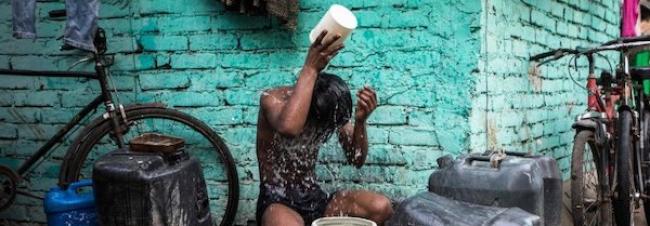Articles Menu

May 12, 2022
There are often moments as an environment journalist when individual stories or facts pull you up short: the bravery of young climate activists prepared to put themselves in harm’s way for our collective futures, for instance, or a new study calmly detailing how another ecosystem is vanishing before our eyes.
But, over the last few weeks, it has been a series of apparently unconnected headlines that have kept me awake at night.
The first of these headlines related to one of a series of devastating heatwaves. These extreme spells have caused large parts of northern India and Pakistan to become all but unliveable, feeling – as one resident told our reporters – "like living in hell".
For many in the northern hemisphere the conditions being experienced in parts of south Asia are difficult to imagine – daytime temperatures topping out above 50C with little respite at night as the heat and humidity remain stifling even after the sun goes down. (If anyone wants to get a sense of what it might be like to live through such terrifying conditions, read the searing opening to Kim Stanley Robinson’s excellent book The Ministry for the Future).
To make matters worse, air conditioning – often a matter of life and death in such conditions – is a remote luxury for many of those at the sharp end of this heatwave, and even those lucky enough to have it are being hit by power outages. Add to this the impact on crops and food supplies and the resident’s reference to “hell” feels chillingly real.
Dirty money
Meanwhile, just a few weeks before temperatures started to spike in India and Pakistan, an entirely different slew of headlines appeared on business pages around the world – this time focusing on the profits of the world’s biggest fossil fuel companies.
“Shell and BP set for £40bn in profits,” cried the newspapers, as BP’s chief financial officer Murray Auchincloss told investors it was “possible that we’re getting more cash than we know what to do with.”
At the same time, in the UK and much of Europe, there has been growing concern over the so-called cost of living crisis. It is, in essence, a story about huge numbers of people being driven into grinding poverty – in large part by rising fuel prices.
And finally, this week we hear that we are nearing the point at which, for the first time, the world breaches the 1.5C global heating limit set by international governments, a chilling reminder that the climate crisis is here and accelerating us towards a cliff edge.
Joining the dots
Are these stories of extreme weather and extreme inequality related? I think they are. And, taken together, surely this is a straightforward case of the lights on the dashboard flashing pretty urgently.
A colleague on the Guardian’s environment team has been arguing for a while that soon most journalism will be climate or environment journalism – at least to a large degree. I am starting to come round to that point of view. As the climate crisis escalates it will have an impact on most aspects of our lives wherever we are living, from security to the cost of living, from where and how we live and move around, to our diets and even our jobs.
The challenge for journalists now, it seems, is not just to report on individual aspects of the climate crisis but to spot the patterns and join the dots – and hopefully hold those responsible to account.
Harjeet Singh is a climate justice campaigner who works for the Fossil Fuel Non-Proliferation Treaty, and has lived through the heatwave in New Delhi. When I spoke to him this week he told me that fossil fuel corporations “knew that the extraction and use of coal, oil and gas damages the environment and causes climate disasters, such as heatwaves and supercharged storms … The result is that poor people in developing countries are on the frontline of the climate crisis and already losing lives, homes and income”.
He emphasized the importance of looking at the bigger picture: “it is a mistake to see these events in isolation – we have to make the links between cause and effect.”